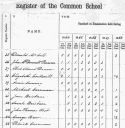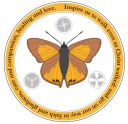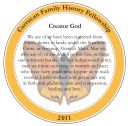|
|

1858 Sandridge Port18 viewsThis photo, taken in 1858, shows the Port of Sandridge (now Port Melbourne). They crossed the Rip, sailed up Port Philip Bay, disembarked at Sandridge and trudged through the tea-tree to Melbourne Town.
|
|

1868 Eltham School Roll62 viewsIn 1864, the Board of Education introduced formal attendance rolls. The original registers from the Eltham Elementary School, beautifully written in copperplate, have survived and give a wonderful insight into the way the school worked. The rolls number the children from number 1 upwards (student number 1 was William James Taylor whose father's occupation was listed as Farmer) and record the age and date of admission and the date of leaving. Just as importantly, they record the number of half-days attended each half year and the examinations passed.
This excerpt shows Michael Carrucan (student 40) and Patrick Carrucan (student 45).
|
|

2012 - WWI Books of Remembrance - Carrucan22 viewsThe Books of Remembrance, carefully inscribed by eight calligraphers, contain the names of the 89,100 members of the Australian Imperial Force, the Royal Australian Navy and the Australian Naval and Military Expeditionary Force who were either born or enlisted in Victoria and served overseas in World War I, or died in camp prior to embarkation. There are thirty-eight Army and Flying Corps Books, one Naval Book and one Sundry Book which contains the names of Victorians who served in non-Australian units. The names appear in alphabetical order with no distinction of rank, although decorations are cited. Where there are identical names, the service number is recorded for further identification. The Books of Remembrance are kept in the Shrine of Remembrance in Melbourne.
This page shows the names of the 5 of the 6 Carrucans who enlisted for WWI.
Thomas Carrucan who enlisted into the Australian Imperial Force (AIF) on the 8th July 1915 at the age of 22 years 9 months. He was among the 36600 men who enlisted in July 1915 as part of the recruitment drive that followed the landing at Gallipoli on the 25th April 1915.
Patrick Carrucan , one of his uncles and then aged 51, enlisted 9 days later on the 19th July 1915 but was discharged medically unfit in Sept 1915. Hence his name does not appear in the Books of Remembrance.
Thomas' first cousin, 25 year old Charles Carrucan, who enlisted on 12th February 1916 and survived after being gassed in France on the 7th June 1917.
Thomas' third cousin, 22 year old William Carrucan, enlisted on the 20th February 1916 and was killed in action on the 3rd March 1917. William was one of Patrick's sons.
Thomas' uncle, 44 year old John Carrucan, lied about his age and enlisted in a tunnelling company on the 25th March 1916.
William's brother, 18 year old Michael Carrucan enlisted into the Australian Army on the 24th January 1918.
Photo by Matthew Carrucan.
|
|

The Carrucan Crest - the Eltham Butterfly21 viewsA poor Irish farming family had little use for a family crest - such things were reserved for those families steeped in power, riches and history.
Matthew Carrucan (Peter Line) has come up with a modern Australian interpretation of the family crest. It features the Eltham Copper Butterfly (Paralucia pyrodiscus lucida), an endangered species of local butterfly that is native to the Eltham area where our forebears settled so many years ago.
Matthew comments that he chose it for the obvious association with Eltham and obviously as it is a metaphor for 'the resurrection' and the continuation or transformations of 'Life after Death' (Peace and Life Eternal).
There are two forms of the crest.
The second version shows the butterfly inside a circle with the final stanzas of our family prayer surrounding it. This version contains 3 symbols, each representing one of our major family lines
Saint Bridget Cross - Bridget Line
Keys - Symbol of Saint Peter - Peter Line
Trefoil - Shamrock - Trinity Symbol Saint Patrick - Patrick Line"
|
|

The Carrucan Crest - the Eltham Butterfly19 viewsA poor Irish farming family had little use for a family crest - such things were reserved for those families steeped in power, riches and history.
Matthew Carrucan (Peter Line) has come up with a modern Australian interpretation of the family crest. It features the Eltham Copper Butterfly (Paralucia pyrodiscus lucida), an endangered species of local butterfly that is native to the Eltham area where our forebears settled so many years ago.
Matthew comments that he chose it for the obvious association with Eltham and obviously as it is a metaphor for 'the resurrection' and the continuation or transformations of 'Life after Death' (Peace and Life Eternal).
There are two forms of the crest.
The second version shows the butterfly inside a circle with the final stanzas of our family prayer surrounding it. This version contains 3 symbols, each representing one of our major family lines
Saint Bridget Cross - Bridget Line
Keys - Symbol of Saint Peter - Peter Line
Trefoil - Shamrock - Trinity Symbol Saint Patrick - Patrick Line"
|
|

Guy Mannering36 viewsThe U.S. ship Guy Mannering was built at New York by William H. Webb, New York, for Robert L. Taylor and Nathaniel W. Merrill's line (called in Liverpool the Black Star Line) of sailing packets between New York and Liverpool, and launched in March 1849.
The ship plied other routes apart from Liverpool – New York. Patrick Carrucan, with his bride Mary and his younger brother Peter, sailed from Liverpool on the Guy Mannering in 1857 on their 90 day voyage to Australia. The shipping records list the travellers, who were not Assisted Migrants, as follows:
... Patrick and Mary Carrocan, ages 30 and 23, married, farmer, Irish, and Peter Carrocan, 24, single, farmer, Irish, on the Guy Mannering in 1857 from Liverpool to Melbourne
|
|

Guy Mannering Painting by Frank Carrucan40 viewsThe U.S. ship Guy Mannering was built at New York by William H. Webb, New York, for Robert L. Taylor and Nathaniel W. Merrill's line (called in Liverpool the Black Star Line) of sailing packets between New York and Liverpool, and launched in March 1849.
The ship plied other routes apart from Liverpool – New York. Patrick Carrucan, with his bride Mary and his younger brother Peter, sailed from Liverpool on the Guy Mannering in 1857 on their 90 day voyage to Australia. The shipping records list the travellers, who were not Assisted Migrants, as follows:
... Patrick and Mary Carrocan, ages 30 and 23, married, farmer, Irish, and Peter Carrocan, 24, single, farmer, Irish, on the Guy Mannering in 1857 from Liverpool to Melbourne
In 2017, Frank Carrucan, the great great grandson of Patrick Carrucan, painted a picture of the Guy Mannering. Here it is!
|
|

1998 Carrucan Reunion30 views1998 Carrucan Reunion
|
|

1998 Carrucan Reunion13 views1998 Carrucan Reunion
|
|

1998 Carrucan Reunion10 views1998 Carrucan Reunion
|
|

1998 Carrucan Reunion23 viewsPeter Line family members at the 1998 Carrucan Reunion
Back: Margaret Hammond nee Clements, Ian Griffith, Gavin Griffith, Martin Griffith and David Griffith
Front: Mary Holden nee Carrucan, Tom Holden, Sarah Griffith, Margaret nee Sloane and Kevin, Mary Clements
|
|

1998 Carrucan Reunion11 views1998 Carrucan Reunion
|
|

Unknown Carrucans30 viewsWe know it's a Carrucan photo but we don't know the names of the 3 ladies. Perhaps we never will.
|
|

Willsmere24 viewsThe Kew Lunatic Asylum was a place where many Carrucans worked, either as nurses, farmers, gardeners, warders or as general hands. As you can see from the photo, it was a huge establishment and was found in Kew on the southern banks of the Yarra River.
Operational from 1871 to 1988, Kew was one of the largest asylums ever built in Australia. Later known as Willsmere, the complex of buildings were constructed between 1864 and 1872 to the design of architects G.W. Vivian and Frederick Kawerau of the Victorian Public Works Office to house the growing number of 'lunatics, inebriates and idiots' in the Colony of Victoria.
Kew continued to operate throughout the 20th century as a 'Hospital for the Insane', 'Mental Hospital' or 'Psychiatric Hospital', treating acute, long-term and geriatric patients until it closed in December 1988. The main building and surrounding grounds were sold by the State Government in the 1980s and were redeveloped as residential properties.
|
|
|
|
|
|
